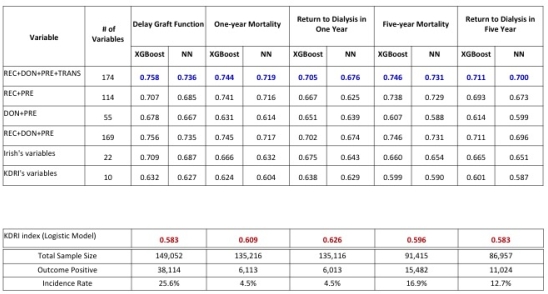Machine Learning to Assess Kidney Donor Risk
Thomas Jefferson University, Philadelphia, PA.
Meeting: 2018 American Transplant Congress
Abstract number: C46
Keywords: Kidney transplantation, Outcome
Session Information
Session Name: Poster Session C: Kidney Donor Selection / Management Issues
Session Type: Poster Session
Date: Monday, June 4, 2018
Session Time: 6:00pm-7:00pm
 Presentation Time: 6:00pm-7:00pm
Presentation Time: 6:00pm-7:00pm
Location: Hall 4EF
Organ quality estimation is critical in allocation and organ acceptance in renal transplantation. Standard methods determine the likelihood of an outcome of interest utilizing Cox regression or logistical regression models. The standard measure of organ quality is kidney donor risk index (KDRI). A nomogram for predicting delayed graft function also exists. Both models suffer from a poor c-statistic limiting their usefulness in clinical practice.
The OPTN database was reviewed and outcomes were supplemented utilizing the USRDS database. 149,052 primary kidney transplants were identified. Primary endpoints included death and death censored graft failure. Secondary endpoint was delayed graft function as defined as requiring dialysis during the first two weeks post-transplant. Input data were divided into recipient (REC), donor (DON), other pre-transplant (PRE) and transplant (TRAN) variable categories. Models were trained using 80% of the sample and tested on the remaining 20%. Machine learning estimations of organ quality was compared to KDRI on five outcome metrics. Two machine learning techniques were utilized: XGBoost and neural network. XGBoost method showed improved c-statistics relative to KDRI in all outcome measures.
Table 1. Model Performance Comparison: Holdout Sample C-statistics
The full XGBoost model was analyzed for positive predictive value and sensitivity.
Table 2. Model Performance Comparison: PPV and Sensitivity
| Outcome | Holdout Sample # | Event # | Incidence | PPV | Sensitivity |
| Delay Graft Function | 29,811 | 7,623 | 25.6% | 43.1% | 69.5% |
| One-year Mortality | 27,044 | 1,233 | 4.5% | 9.2% | 63.0% |
| Return to Dialysis in One Year | 27,024 | 1,203 | 4.5% | 8.2% | 64.1% |
| Five-year Mortality | 18,283 | 3.096 | 16.9% | 29.6% | 70.8% |
| Return to Dialysis in Five Year | 17,392 | 2,205 | 12.7% | 21.9% | 63.9% |
Machine learning algorithms demonstrated improvement in predictive accuracy in all post transplant measures relative to current standards. Further algorithm refinement and development is necessary to improve these results for clinical use.
CITATION INFORMATION: Shah A., Li M., Chen Z. Machine Learning to Assess Kidney Donor Risk Am J Transplant. 2017;17 (suppl 3).
To cite this abstract in AMA style:
Shah A, Li M, Chen Z. Machine Learning to Assess Kidney Donor Risk [abstract]. https://atcmeetingabstracts.com/abstract/machine-learning-to-assess-kidney-donor-risk/. Accessed December 25, 2025.« Back to 2018 American Transplant Congress

